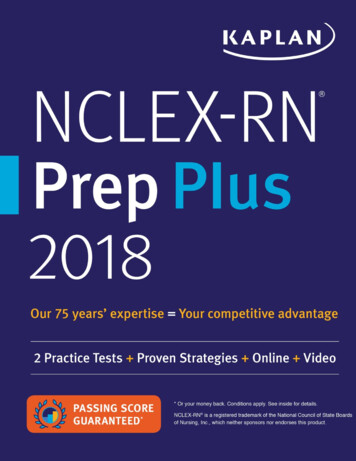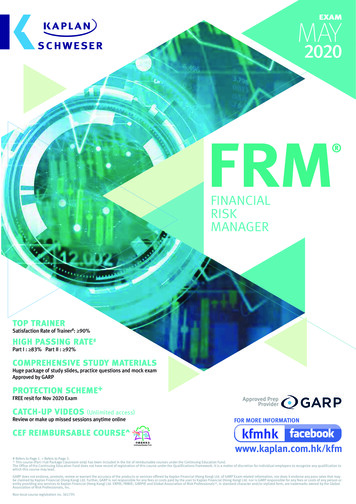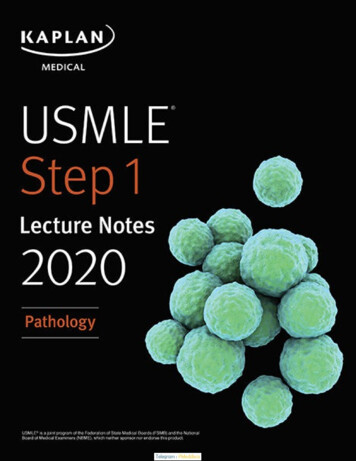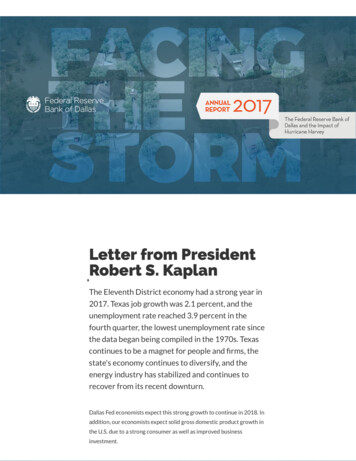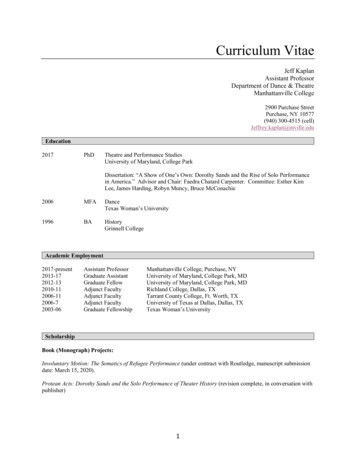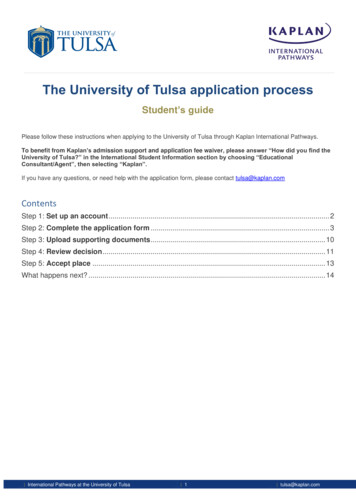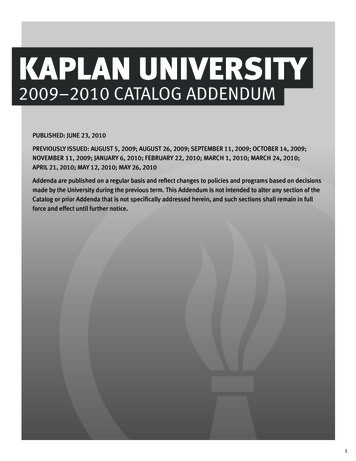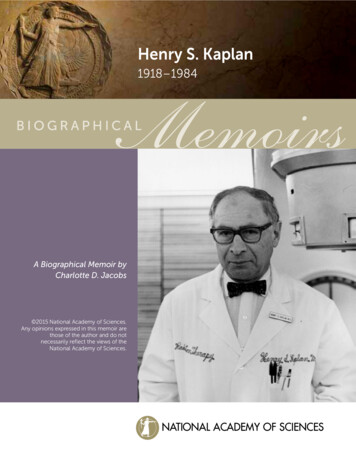
Transcription
Henry S. Kaplan1918–1984A Biographical Memoir byCharlotte D. Jacobs 2015 National Academy of Sciences.Any opinions expressed in this memoir arethose of the author and do notnecessarily reflect the views of theNational Academy of Sciences.
HENRY SEYMOUR KAPLANApril 24, 1918–February 4, 1984Henry Kaplan remains one of the most prominent physician scientists in the history of cancer medicine. A giftedlaboratory investigator, he discovered a radiation leukemiavirus (RadLV) in mice. His finding—that a latent RNAvirus, when activated by radiation exposure, could causeleukemia/lymphoma in mice—established a link betweenan external cancer-causing agent and a virus. This workwas considered a milestone for subsequent studies onleukemogenesis.With physicist Edward Ginzton, Kaplan invented a medicallinear accelerator that revolutionized the treatment ofcancer with radiation. When Kaplan began his work onHodgkin’s disease in the early 1950s, it was consideredBy Charlotte D. Jacobsa fatal illness. Today, almost ninety percent of Hodgkin’spatients survive, in large part because of his work. He andoncologist Saul A. Rosenberg brought together a multidisciplinary team, initiating theera of modern cancer clinical trials and providing a model for the cure of other cancers.Finally, Henry Kaplan was the consummate clinician and mentor, beloved by his patientsand trainees.Early lifeaplan’s mother, Sarah Brilliant, was born in Kiev during the reign of Tsar NicholasII. When pogroms targeted the Jewish population, her family emigrated, settling onChicago’s west side. There she met and married dentist Nathan Morris Kaplan. On April24, 1918, their first son, Henry, was born. He had two giant fingers on his right hand.Horrified, his mother tried to persuade a surgeon to amputate them. “Just make himstrong,” advised the pediatrician, and that’s what she set out to do.1KWhen Henry was six, his brother Richard was born, after which four cousins came tolive with them. The Kaplans were doing well until 1934, when in the midst of the GreatDepression, Nathan was diagnosed with advanced lung cancer. At sixteen, Henry became2Courtesy of Lane Medical Archives, Stanford University Medical Center.Elected to the NAS, 1972
H EN RY K A P L A Nhis father’s nurse while his mother returned to work, opening a pharmacy. Following hisfather’s funeral, Henry announced to his family, “Someday I’m going to cure cancer.”2Initial research experiencesWhile attending the University of Chicago, Kaplan worked up to seventy hours a weekto help maintain the family pharmacy. In 1937, he entered Rush Medical College, wherehe became intoxicated with basic science. An internship at Michael Reece Hospitalfollowed. At the time, most cancer research was performed by surgeons and radiotherapists. Kaplan chose the latter as his profession, and in 1943 he began radiology trainingat the University of Minnesota with Leo Rigler.In Kaplan’s first research project, he and Rigler discovered that patients with perniciousanemia had an increased risk of developing gastric adenocarcinoma, which suggested animportant role for screening in this disease. Yet, Kaplan was determined to ascertain howhealthy cells transformed into malignancies.Working in Arthur Kirschbaum’s laboratory, he learned basic cancer biology researchskills. The aim of his first project was to determine whether radiation could inducetumors of lymphoid tissue in mice, which seemed a good system to study carcinogenesis.They treated mice with total body irradiation and found it generated lymphomas andleukemias in certain mouse strains.In 1945, Kaplan assumed his first academic appointment at Yale University, where hecontinued to investigate the genesis of leukemia and lymphoma using mice from LeonellC. Strong’s famed mouse colony. “I was my own caretaker and technician,” Kaplanrecalled, “and my first year’s entire research budget was approximately 250.”3He began by irradiating a strain of inbred mice, C57BL blacks, which had a low chanceof developing malignancies spontaneously. It was while investigating the influence of ageat time of radiation exposure that he made an observation relevant to human disease.Most experts at that time believed that lymphoid cancers arose simultaneously frommultiple foci, making them incurable. However, in his irradiated mice, Kaplan notedthat lymphomas first appeared in the thymus gland, spread to adjacent lymph nodes,then to other organs, and finally entered the bloodstream. If this was the mode of spreadin humans, it had major implications for potentially curative treatment. Exhilarated byscience, Kaplan called his laboratory his golf course; his wife, Leah, called it his mistress.43
H EN RY K A P L A NThe early years at Stanford UniversityIn 1948, Dean Loren Chandler resolved to renew Stanford’s medical school, located inSan Francisco, and raise it out of mediocrity. His first recruitment was Henry Kaplanas chairman of radiology. Kaplan accepted the position because he wanted to create hisideal of an academic radiology department, and considering the immense resources onthe main campus in Palo Alto, he felt confident he could play a major role in creatinga first-rate academic medical center. With his legendary determination, Kaplan helpedorchestrate the school’s move to Palo Alto. He maintained that a medical school at a greatuniversity had a special mission—to innovate, to discover—and he pushed to recruitoutstanding researchers. To that end, Kaplan fought hard, whether against other faculty,the dean, or the board of trustees. He remained chairman of the Radiology Departmentat Stanford University School of Medicine for more than two decades.Development of a medical linear acceleratorIn the 1950s, the cobalt 60 unit was the best available radiotherapy machine. It emittedgamma rays in the 1.2 million volt range, but with limited accuracy. Kaplan referred tothe cobalt unit as a “shotgun,” and said he wanted a rifle.5 To design such a machine, hehad to be able to produce and harness high-energy x-rays and direct them to a target withprecision.Stanford physicists Edward Ginzton and Bill Hansen had recently built a powerful sourceof microwaves, the klystron, which was the heart of a linear accelerator they constructedfor physics research. When Kaplan heard about this atom smasher at a cocktail party,he contacted Ginzton about designing a medical linear accelerator to treat cancer. Theyplanned a six-million-volt accelerator on a moveable base so they could rotate the beamin various directions, allowing them to treat patients from several angles. In 1954, theycompleted construction of a medical linear accelerator that delivered radiation with suchaccuracy and potency that it has changed the outcome for cancer patients worldwide.Research on carcinogenesisIn the midst of organizing his department and developing the linear accelerator, Kaplanbegan to assemble his laboratory in a renovated Victorian house, with the help of just oneassistant. Having discovered that radiation-induced leukemia and lymphoma begin inthe thymus gland, he concentrated his efforts specifically on those cells. In his next set ofexperiments, rather than delivering total body irradiation, he directed the radiation beamto the thymus, because radiation was thought to cause cancers by direct damage to theirradiated tissue. To his surprise, these irradiated mice remained healthy. This presented4
H EN RY K A P L A Na paradox: total body radiation induced acancer in the thymus, but direct radiationto the thymus didn’t. Kaplan concludedthat the prevailing theory of radiation-induced carcinogenesis was incorrect. Thesetumors were not caused by direct radiation damage, as always presumed, butrather by some indirect mechanism.To prove this, he removed the thymusglands from a group of C57 black miceand treated the mice with total bodyirradiation. Then he transplanted thymusglands from healthy mice that had neverbeen exposed to radiation into the irradiated mice. Lymphomas developed in thetransplanted thymus glands even thoughthose glands had not been exposed toradiation. Kaplan concluded that radiation-induced cancers of mouse thymusoriginated not from cells damaged bydirect x-ray exposure, but from someHenry Kaplan working on the Stanford linearsystemic, activated factor that transformedaccelerator, ca. 1953. (Courtesy of Lane Medicalnormal lymphocytes into malignant ones.Archives, Stanford University Medical Center.)In 1951, Ludwik Gross maintainedthat a virus caused leukemia in mice. Although Kaplan initially didn’t believe Gross’sassertion, he began to follow Gross’s work closely, and with time, found the theory morecompelling. “Confronted by the paradox that radiation acts by an indirect mechanism,”he said, “and stimulated by Gross’s discoveries, we were led to consider the possibilitythat an agent similar to the Gross virus might play a role in the indirect development ofthymic lymphomas.”6 Microbiologist Miriam Lieberman joined Kaplan’s lab in 1959,and together they performed what would be considered a landmark experiment in viraloncology.They began by delivering total body irradiation to C57BL mice, and as anticipated,most of the mice developed lymphoma. The researchers prepared filtrate solutions from5
H EN RY K A P L A NKaplan’s clinical researchfocused on Hodgkin’s disease.In the early fifties, when heentered the field of radiationtherapy, only five percent ofpatients with this malignancysurvived. Radiotherapy wasthe sole effective treatment,but the equipment for thisprocedure was rudimentary,and treatment planninghaphazard.lymphomatous tissue and inoculated newborn micewith it. If Kaplan was correct, the filtrate shouldcontain viruses that would generate lymphomain the newborns. After eighteen months of observation, they saw no lymphomas, and Kaplanbecame discouraged. Then, at two years after inoculation, the first thymic lymphoma appeared in arecipient, and before long, seventeen percent of themice developed lymphomas.“The essence of what we discovered,” Kaplan said,“is that mouse leukemias, which were ostensiblycaused by x-rays and certain chemicals, were infact due to latent viruses triggered into activityby exposure to x-rays. The animals can live acompletely normal life span without ever evincing the fact that they harbor these viruses,if they are not exposed.”7Nine years later, in 1968, Kaplan and his colleagues identified an RNA virus in thethymus gland of the mice and then in the filtrates themselves. Furthermore, they coulddetect these viruses months before the appearance of cancer. Kaplan called this new agent“radiation leukemia virus” (RadLV). Joining the ranks of pioneers in tumor virology,Kaplan, like Gross before him, became obsessed with finding a virus that causes humancancer.Curing Hodgkin’s DiseaseKaplan’s clinical research focused on Hodgkin’s disease. In the early fifties, when heentered the field of radiation therapy, only five percent of patients with this malignancy survived. Radiotherapy was the sole effective treatment, but the equipment forthis procedure was rudimentary, and treatment planning haphazard. Armed with hislinear accelerator, Kaplan set out to cure what most considered a fatal cancer. He knewhe couldn’t do it alone, however; he needed an expert team: a surgeon, a pathologist,a radiologist, and an oncologist. In 1961, medical oncologist Saul Rosenberg came toStanford. A year later, Stanford commenced randomized clinical trials, setting a modelfor multidisciplinary trials and opening a new chapter in the history of Hodgkin’s disease.6
H EN RY K A P L A NAll they knew at the time was that Hodgkin’s disease had a predilection for young adults,who usually presented with a mass in the neck or chest. Although their disease couldbe arrested with irradiation, it frequently recurred. In order to design more effectivetherapies, the research team needed to determine the stage of the disease at the time ofpresentation, and they needed to know how far it had spread. So Kaplan and Rosenbergperformed a series of tests in newly diagnosed patients to detect all sites of disease—aconcept called staging. They began to subject patients to staging laparotomy, in whichthe surgeon sampled intra-abdominal nodes, biopsied the liver and removed the spleen.What they found was frequent, unsuspected disease in the abdomen, disease that neededto be detected and treated if patients were to be cured.In the early sixties, most radiotherapists treated Hodgkin’s disease with low doses tosmall fields. Kaplan believed they needed to deliver radical radiotherapy—irradiation toinvolved lymph nodes and uninvolved adjacent nodes for prophylaxis—using doses ashigh as 4000 to 5000 rads. To perform treatment in this way, he designed two radiationports: the mantle, so named because its shape resembled a sleeveless cloak to encompassall major lymphatics of the upper torso while sparing the lung, heart, and spinal cord;and the inverted Y, which covered major lymphatics in the abdomen and both groins.Kaplan advocated doses and radiation ports never before employed. Despite intensecriticism, he and Rosenberg persisted and in the first series of randomized trials, theydemonstrated improved outcomes in patients who were treated with this approach.In 1967, oncologist Vince DeVita at the National Cancer Institute reported that with anew four-drug combination called MOPP, he had achieved high response rates in patientswith the most advanced stages of Hodgkin’s disease. Prior to that, single-agent chemotherapy had been used for palliation. Kaplan postulated that if MOPP was effective inpatients with stage IV disease, as DeVita had shown, its potential for earlier stage diseasemight be even greater, especially if combined with irradiation. The results from the seriesof Stanford combined-modality treatments proved superb. Their later trials focused onreducing toxicity while maintaining high cure rates. As a result of Kaplan and Rosenberg’s collaboration, which spanned two decades, in addition to the efforts of otherresearchers, the majority of patients with Hodgkin’s disease are cured today.Further cancer biology workIn 1975, Kaplan became director of Stanford’s new Cancer Biology Research Laboratory,where he strived to isolate a human lymphoma virus. He postulated that if scientistscould determine the causative virus, they could develop a vaccine to prevent cancer.7
H EN RY K A P L A NAlthough he and co-workers established a number of in vitro human lymphoma celllines, Kaplan never found a human tumor virus, though the search lasted for the rest ofhis career. Later in life, he and co-workers worked on developing monoclonal antibodiesto treat cancer.RecognitionKaplan received numerous honors and awards. In 1969, he was the first physician toreceive the Atoms for Peace Prize. He was elected to membership in the AmericanAcademy of Arts and Sciences and in 1972 was the first radiologist inducted into theNational Academy of Sciences. That same year, he was named the Maureen LylesD’Ambrogio Professor at Stanford University. He received the David KarnofskyMemorial Award from the American Society for Clinical Oncology, the Robert Roeslerde Villiers Award of the Leukemia Society of America, and the first Gold Medal from theAmerican Society of Therapeutic Radiologists.Kaplan was recognized worldwide for his accomplishments: by the French Legion ofHonor in 1965; with the Order of Merit from the Republic of Italy and the Shahbanou Award of the Lila Motley Cancer Research Foundation and the Empress of Iranin 1969. He became an Honorary Fellow of the Royal College of Radiologists, UnitedKingdom, in 1975; he received the Prix Griffeul from France in 1977; and the DanishCancer Society awarded him the first Medal of Honor in 1978. In 1979, he was the firstrecipient of the Charles F. Kettering Prize from the General Motors’ Cancer ResearchFoundation.A multifaceted manAmong Kaplan’s greatest joys were the thousands of patients he treated throughout hiscareer. A superb clinician, he expressed deep compassion for his patients and extendedhimself to them and their families, even housing a number of them in his home whenthey came to him for treatment from abroad.Kaplan also traveled extensively, teaching radiotherapists around the world how to treatHodgkin’s disease. He cared deeply for his trainees. A model physician and teacher, hestimulated them to solve problems through research, thereby fostering their careers.Many of his students and residents became leaders in the cancer field.Despite his busy schedule, Kaplan also engaged in the politics of science, serving onthe National Cancer Advisory Board and numerous other groups to influence cancercare and research nationwide. Perhaps of greatest import was his participation in the8
H EN RY K A P L A NYarborough Committee, which was responsible for crafting President Nixon’s NationalCancer Act of 1971. The mastermind behind the effort, Mary Lasker, insisted that theUnited States needed a “moonshot” for cancer.8 She maintained that the cure of cancerwould require a specific tactical plan, a major investment in funds, and an independentagency, outside control of the National Institutes of Health (NIH), that would reportdirectly to the President. Although Kaplan agreed they needed more funds, he arguedfor scientific freedom and railed against what he called the “managed approach to bigscience.”9 He thought it ill advised to carve the National Cancer Institute out of theNIH. Kaplan was so forceful at Congressional hearings that he discredited some of theCommittee’s work. The final legislation substantially increased federal funds for cancerresearch and made the director of the National Cancer Institute a Presidential appointee,but it did not mandate what specific cancer research scientists could conduct. Kaplanbelieved in scientific freedom and risked his reputation to preserve it for U.S. scientists.On an international level, Kaplan helped researchers set up their labs and obtainresources, and he advised several countries how to construct modern facilities to treatpatients and conduct research. Kaplan was troubled to see scientists whose potential washampered by lack of proper instruction and resources, but when he learned of those whohad lost their freedom, he became incensed.Among all the human rights issues with which he became involved, none disturbed himmore than the plight of Argentine scientists during the “dirty war,” the conflict betweenArgentine security forces, or the junta, and Argentine citizens who were associated withsocialism. In 1978, he led a boycott against the International Cancer Congress, held inBuenos Aires, to draw attention to the thousands of Argentineans who had simply disappeared during the conflict. The junta knew of his role in these activities. Had he been anArgentine scientist, he would likely have been tortured and then executed. Yet, Kaplanrisked his life by traveling to Argentina to try to save the scientists who constituted asignificant number of those who had disappeared.10FamilyDuring his third year of medical school, Kaplan met Leah Lebeson, whom he marriedin 1942. Leah was the perfect wife for Kaplan. She allowed, and even encouraged,her husband to be single-minded in his quest to cure cancer. While raising their twochildren–Ann, who became a lawyer, and Paul, who became a film maker and massagetherapist—Leah developed her own career, first as a psychiatric social worker, then asStanford’s assistant dean of student affairs. She had an incredible warmth and sense9
H EN RY K A P L A NHenry Kaplan with his wife Leah. (Courtesy of the Kaplan family.)of humor. And she understood that at her husband’s core lay a passion—a passion tocure cancer—that dominated his life and his relationships. He once told Leah that heconsidered cancer his “Moby Dick.”11Illness and deathOn September 28, 1983, Kaplan was diagnosed with locally advanced lung cancer. Heha
Finally, Henry Kaplan was the consummate clinician and mentor, beloved by his patients and trainees. HENRY SEYMOUR KAPLAN April 24, 1918–February 4, 1984 Elected to the NAS, 1972 By Charlotte D. Jacobs Courtesy of L
